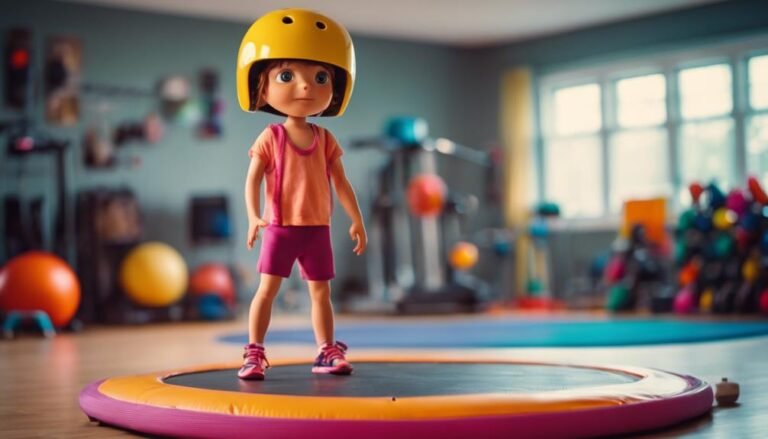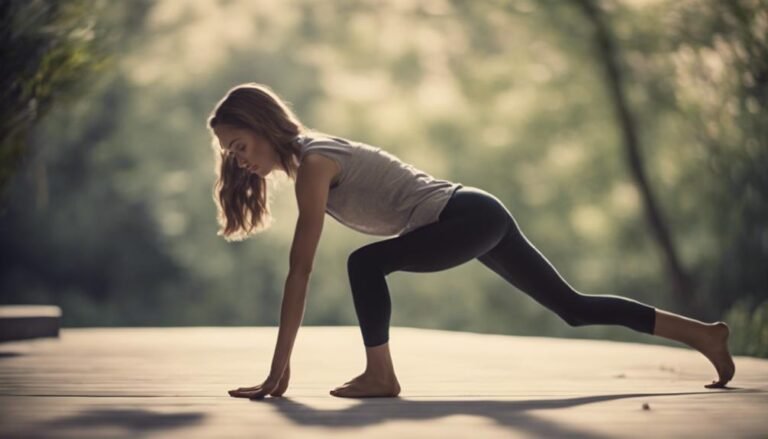Don't miss our holiday offer - 20% OFF!

Simple Yoga Routines for Children
Kids can blossom into happy, healthy, and focused individuals with simple yoga routines that cultivate their physical, emotional, and social growth.
We're excited to introduce simple yoga routines into our daily lives to help our little ones develop physically, emotionally, and socially. By creating a nurturing environment, we can foster a lifelong appreciation for yoga's numerous benefits. We'll focus on short, playful sessions that spark curiosity and encourage exploration. We'll prioritize developmental needs, promoting physical, emotional, and social growth. Let's explore gentle guidance, calming atmospheres, and engaging yoga poses and exercises that bring mindfulness and fun to our practice. As we get started, we'll discover even more ways to support our children's overall well-being.
Key Takeaways
- Create a nurturing environment with soothing colors, cozy textiles, and minimal distractions for a peaceful yoga practice.
- Introduce simple yoga poses like Tree Pose, Butterfly Pose, and Downward-Facing Dog, using props to make it engaging and fun.
- Practice gentle stretches like toe touches, arm circles, and side bends to promote flexibility and relaxation.
- Teach mindful breathing techniques like belly breathing, 4-7-8 breathing, and box breathing to calm down and focus.
- Incorporate imaginative language and storytelling into yoga practice to encourage exploration and creativity.
Yoga for Toddlers: Getting Started
As we begin introducing yoga to our toddlers, we'll focus on short, playful sessions that spark their curiosity and encourage exploration. At this age, prioritizing their developmental needs is vital, and yoga can be a fantastic way to support their growth. We'll create a nurturing environment that fosters their Toddler Development, promoting physical, emotional, and social growth.
As parents, we'll provide gentle guidance, offering a sense of security and comfort as they navigate this new experience. Our role is vital in helping them feel at ease, allowing them to fully engage with the practice. By doing so, we'll help build their confidence and encourage them to explore their bodies and surroundings. Through Parental Guidance, we'll create a safe space for our little ones to learn, grow, and have fun. By adopting this approach, we'll lay the foundation for a lifelong appreciation of yoga and its numerous benefits. Let's venture on this wonderful journey together, nurturing our toddlers' development and watching them blossom into happy, healthy, and well-rounded individuals.
Simple Poses for Little Ones
We'll start with simple, fun poses that our little ones can easily follow, letting them explore and engage with their bodies in a playful way. We want to make yoga accessible and enjoyable for them, so we'll focus on kid-friendly modifications that cater to their unique needs and abilities.
Here are some simple poses that our little ones can start with:
| Pose | Description |
|---|---|
| Tree Pose | Stand on one leg, arms by your sides, and focus on balance. |
| Butterfly Pose | Sit with legs bent, feet together, and flap your legs like wings. |
| Downward-Facing Dog | Start on all fours, then lift hips up and back, straightening arms and legs. |
As we explore these poses, we can incorporate yoga props to make it more engaging and fun. Blocks, straps, and blankets can help our little ones feel more grounded and confident in their practice. We can also use imaginative language to bring the poses to life, encouraging our kids to explore and express themselves through movement. By making yoga a positive and enjoyable experience, we can set our little ones up for a lifelong journey of self-discovery and wellness.
Breathing Exercises for Kids
As we explore the world of yoga for kids, we're excited to share some essential breathing exercises that can help our little ones relax and focus. We'll learn simple techniques to calm down and breathe deeply, which can be a game-changer for their emotional and physical well-being. By teaching kids these valuable skills, we can empower them to manage stress and anxiety, and set them up for a lifetime of wellness.
Calm Down Techniques
When we feel anxious or upset, our breath can become shallow and rapid, but learning simple breathing exercises can help calm our minds and bodies. As we practice these exercises, we can better manage our emotions and respond to challenging situations.
One effective way to calm down is through mindful breathing. We can take slow, deep breaths in through our nose and out through our mouth, focusing on the sensation of the breath moving in and out of our body. This helps calm our nervous system and reduce feelings of anxiety.
Here are some relaxation strategies we can try:
| Technique | How it Works | Benefits |
|---|---|---|
| Belly Breathing | Focus on expanding our belly as we inhale | Slows down our heart rate and calms our mind |
| 4-7-8 Breathing | Inhale for 4 counts, hold for 7, exhale for 8 | Reduces anxiety and promotes relaxation |
| Box Breathing | Inhale for 4 counts, hold for 4, exhale for 4, hold for 4 | Improves focus and calms our nervous system |
Deep Breathing Methods
Deep breathing methods can become a powerful tool in our kids' emotional toolbox, helping them navigate life's ups and downs with greater ease and confidence. By teaching our kids deep breathing exercises, we can empower them to manage stress, anxiety, and frustration in a healthy, constructive way. One effective technique is diaphragm expansion, where our kids learn to breathe deeply into their belly, rather than shallowly into their chest. This helps slow down their heart rate, calm their nervous system, and think more clearly. Another beneficial technique is nasal cleansing, where our kids use a neti pot or saline rinse to clear out their nasal passages and breathe more freely. We can make these exercises fun and engaging by incorporating games, visualizations, and storytelling. For example, we can ask our kids to imagine they're blowing up a balloon in their belly, or that they're breathing in fresh, clean air and exhaling out any worries or fears. By practicing these deep breathing methods regularly, our kids can develop greater emotional resilience and a sense of calm in the midst of chaos.
Yoga Games for Fun Learning
As we explore yoga games for fun learning, we're excited to share some engaging activities that will make yoga a delightful experience for kids. We'll show you how to create an immersive experience with animal poses, go on a yoga scavenger hunt, and bring stories to life with movement. By incorporating these games into our yoga routine, we'll make learning fun and interactive for our little ones.
Animal Poses Fun
How can we make yoga more engaging and entertaining for kids, while still teaching them valuable lessons about focus, balance, and strength? We believe that incorporating animal poses into our yoga routines is the perfect solution! By mimicking the movements and behaviors of our furry and feathered friends, kids can have a wild adventure while learning valuable skills.
Let's start with some pet friends that kids love, like cats, dogs, and rabbits. We can practice 'cat-cow' poses, 'puppy dog' stretches, and 'bunny hop' jumps. These fun and interactive poses help kids develop flexibility, coordination, and balance. We can also create a 'safari' atmosphere, where kids can explore and imitate the movements of wild animals like lions, giraffes, and monkeys. This not only encourages physical activity but also stimulates their imagination and creativity.
As we venture on these wild adventures, we're not only having fun but also building confidence, focus, and self-awareness. By embracing our inner 'animal,' kids can develop a stronger connection with their bodies and the world around them. So, let's get moving, and set free our inner wild child!
Yoga Scavenger Hunt
Let's create a yoga scavenger hunt that takes kids on an exciting adventure, where they'll search for and discover new poses, breathing techniques, and mindful moments, all while developing their problem-solving skills and teamwork. We'll set up a series of yoga obstacles, like "Find a partner and do a tandem tree pose" or "Hop on one foot to the next station," that challenge them to think creatively and work together. As Nature Explorers, we'll hide cards with yoga poses or breathing exercises in a designated area, and have the kids search for them. Each card will have a fun, nature-inspired challenge, like "Find a leaf that's shaped like a heart and do a heart-opening pose" or "Find a pinecone and balance on one leg while smelling its scent." As they search, they'll develop their observation skills, practice mindfulness, and get some exercise too! We'll time them and challenge them to beat their own time on subsequent rounds, encouraging them to work together and have fun while doing it. Who knows, they might just discover a new favorite pose!
Movement Story Time
We're excited to introduce Movement Story Time, a unique approach to learning that combines yoga, storytelling, and fun games to engage kids and help them develop essential skills like focus, balance, and self-awareness. Through Movement Story Time, we create imaginative scenarios that transport kids on exciting adventures, encouraging them to explore and express themselves physically and creatively. We'll set off on imaginary journeys, exploring enchanted forests, sailing across vast oceans, or even venturing into outer space! As we move through these fantastical worlds, we'll incorporate yoga poses, breathing exercises, and meditation techniques to help kids develop their coordination, flexibility, and concentration.
To enhance the experience, we'll incorporate Music exploration, using different rhythms and melodies to evoke emotions, inspire creativity, and encourage physical expression. By combining movement, storytelling, and music, we'll create a holistic learning environment that fosters confidence, creativity, and self-awareness. As we journey through Movement Story Time, we'll laugh, learn, and grow together, cultivating a lifelong love for yoga, creativity, and self-expression.
Building Strength and Confidence
As we guide our kids through yoga, we're empowering them to build strength and confidence, laying the foundation for a lifelong journey of self-discovery and self-acceptance. By incorporating flexibility exercises into their yoga practice, we're helping them develop a positive body image and a sense of self-worth.
Here are some yoga poses that can help build strength and confidence in kids:
| Pose | Benefits | Age Range |
|---|---|---|
| Tree Pose | Improves balance and focus | 4-6 years |
| Downward-Facing Dog | Strengthens arms and legs | 5-7 years |
| Cobra Pose | Opens chest and improves posture | 6-8 years |
| Warrior Pose | Builds strength and confidence | 7-10 years |
| Mountain Pose | Improves posture and balance | 5-10 years |
As we practice yoga with our kids, we're teaching them valuable lessons about body positivity and self-acceptance. By focusing on their strengths and abilities, we're helping them develop a positive self-image and a sense of confidence that will benefit them throughout their lives.
Gentle Stretches for Growing Bodies
We need to support our kids' rapidly growing bodies with gentle stretches that promote flexibility and relaxation, helping them release tension and stay comfortable in their own skin. As they reach various flexibility milestones, introducing stretches that target different muscle groups is vital. This helps build muscle awareness, enabling them to understand and control their bodies better.
We can start with simple stretches like toe touches, arm circles, and side bends. These exercises help loosen up tight muscles, improve posture, and enhance overall flexibility. Focusing on hip openers is also vital, as they promote flexibility in the hips and legs, which are fundamental for balance and coordination. As we guide our kids through these stretches, we're not only helping them develop physically but also teaching them valuable skills like self-awareness and self-regulation. By incorporating gentle stretches into their daily routine, we're giving them the tools they need to thrive in both body and mind.
Mindfulness for Calm Kids
Let's tune in to our kids' emotions and teach them mindfulness techniques that calm their minds and soothe their spirits. As parents, we want our children to feel grounded and centered, especially in today's fast-paced world. Mindfulness is an incredible tool to help them do just that.
We can start by introducing peaceful mornings into our daily routine. Imagine beginning the day with a gentle, guided meditation or some quiet reflection. This sets the tone for a calm and focused day ahead. We can also incorporate mindfulness into our daily activities, like eating or walking. By encouraging our kids to focus on their breath, body, and surroundings, we help them develop a greater sense of awareness and calm.
Let's take a few minutes each day to sit comfortably, close our eyes, and breathe deeply together. As we inhale and exhale, we can silently repeat a calming phrase, like "I am calm and capable." This simple practice helps our kids develop self-awareness, manage their emotions, and respond to challenges with greater ease. By teaching mindfulness, we empower our children to navigate life's ups and downs with confidence and serenity.
Yoga for Emotional Well-being
Practicing yoga with our kids can be a powerful way to help them develop emotional intelligence, self-awareness, and resilience. As parents, we want our children to grow up with the ability to navigate their emotions, manage stress, and develop a sense of calm and confidence. Yoga can be a valuable tool in helping our kids achieve this.
| Emotional Regulation | Mindful Parenting | Yoga Benefits |
|---|---|---|
| Recognizing emotions | Creating a calm environment | Reduces anxiety and stress |
| Identifying triggers | Modeling emotional regulation | Improves mood and focus |
| Developing empathy | Encouraging open communication | Fosters self-awareness and confidence |
Creating a Home Yoga Space
As we create a home yoga space for our little ones, we want to prioritize a calming atmosphere that fosters a sense of tranquility and relaxation. To achieve this, we'll focus on incorporating essential elements that promote serenity, designating a specific zone for yoga practice, and minimizing distractions that might disrupt our children's focus. By doing so, we'll set the stage for a peaceful and engaging yoga experience that our kids will love.
Calming Atmosphere Essentials
By intentionally curating a serene environment, we can create a sense of tranquility that sets the tone for a peaceful and engaging yoga practice for our children. As we prepare our home yoga space, we want to create an atmosphere that promotes relaxation and calmness. This will help our little ones feel comfortable and focused, allowing them to fully immerse themselves in the yoga experience.
To achieve this, we can incorporate some essential elements into our space. Here are a few of our favorites:
- Soothing Colors: Soft hues like light blue, pale green, and creamy white can create a calming ambiance.
- Cozy Textiles: Plush rugs, soft blankets, and comfortable cushions can make our yoga space feel like a warm hug.
- Natural Light: Whenever possible, we try to practice near a window to let in some natural light and fresh air.
- Calming Scents: A gentle lavender or vanilla aroma can promote relaxation and reduce anxiety.
- Minimal Distractions: By removing electronic devices and other distractions, we can create a peaceful atmosphere that encourages mindfulness.
Designate Yoga Zone
We'll dedicate a specific area in our home to yoga, transforming it into a serene oasis where our children can stretch, breathe, and thrive. As we create this peaceful space, we'll consider the yoga decor that will inspire our little ones to relax and have fun. We'll choose calming colors, soft lighting, and comfortable flooring that invites our kids to sit, stretch, and play.
Next, we'll establish zone boundaries to define our yoga space. This means setting aside a quiet area free from distractions, where our children can focus on their yoga practice. We'll remove any clutter, toys, or electronic devices that might divert their attention. By setting these boundaries, we'll create a sense of safety and structure, allowing our kids to fully engage with their yoga practice. With a designated yoga zone, we're giving our children the gift of a peaceful retreat, where they can develop their physical and emotional well-being.
Minimal Distractions Allowed
In creating a home yoga space, let's intentionally remove or silence potential distractions, like TVs and electronic devices, to carve out an environment that fosters mindfulness and calmness. We want our little yogis to focus on their breath, movements, and inner selves, not on the latest cartoon episode or video game.
To achieve this, let's create a peaceful atmosphere by:
- Turning off notifications on our phones and putting them on silent mode
- Moving the TV to a different room or covering it with a blanket
- Asking family members to keep their voices down or take conversations outside
- Using calming colors and soft lighting to create a soothing ambiance
- Placing a "Do Not Disturb" sign on the door to signal our yoga time
Making Yoga a Family Affair
As we explore ways to share yoga with our kids, let's not forget the incredible benefits of practicing together as a family. This not only strengthens our Family Bonding but also sets a great example for our little ones. By incorporating yoga into our Morning Routine, we can create a sense of calm and focus that lasts throughout the day. Imagine starting your day with a gentle flow, breathing in sync with your child, and feeling the love and connection that comes with it.
We can begin by keeping it simple – just 10-15 minutes a day. We can find a quiet spot in our home, roll out our mats, and get started. Our kids will love the quality time, and we'll love watching them grow and thrive. As we practice together, we'll build trust, communication, and a deeper understanding of each other. By making yoga a family affair, we're giving our kids the gift of a healthy lifestyle, and a sense of connection that will last a lifetime. So, let's get started, and see the magic unfold!
Frequently Asked Questions
Can Children With Special Needs Practice Yoga?
"We believe that every child, regardless of ability, deserves to experience yoga's benefits. We adapt our teaching to include inclusive classes and modified poses, ensuring all kids can participate and thrive in a supportive environment."
How Often Should Kids Practice Yoga Each Week?
We believe that establishing a daily routine is key, aiming for 2-3 times a week, with 10-15 minute sessions, to help kids develop a consistent practice and achieve their weekly goals, gradually increasing as they grow.
Can Yoga Help With Bedtime Routines for Kids?
"Can we imagine a bedtime routine without tantrums and struggles? We believe yoga can be a game-changer! It helps kids calm down, relax, and unwind, making Sleepy Time a peaceful experience for the whole family."
Are There Yoga Routines for Kids With Adhd?
We've seen how yoga can help kids with ADHD by incorporating Fidget Breaks, allowing them to release excess energy, and Focus Games that challenge their minds, helping them stay calm and centered.
Can Yoga Help With Bullying and Self-Esteem Issues?
"Oh, the millions of times we've witnessed bullying and self-esteem issues break hearts! But, thankfully, yoga can be a game-changer! By fostering empathy building and confidence boosters, yoga helps kids develop a stronger sense of self-worth, making them more resilient to bullying."
Conclusion
As we wrap up our exploration of simple yoga routines for children, we're reminded that 94% of parents report a significant reduction in their child's stress levels after just a few weeks of practicing yoga together! That's powerful stuff. By incorporating yoga into our daily lives, we can help our little ones develop strength, confidence, and a sense of calm. So let's keep stretching, breathing, and growing together – our kids will thank us!



